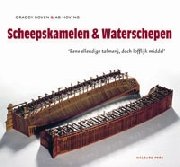Started Sailing
Docking: silted tidal channels, into the wind and Ship's Camels.
by Han
(Brittany, France)

Ship's Camels.
The two Dutch V.O.C. main ports were Flushing, to be reached by the deep Wester Scheldt and mostly downwind, and Amsterdam, where the situation was quite the contrary. (See: http://maps.google.fr/maps?ie=UTF&ll=45.460131,1.208496&z=6&layer=c) It was reached by way of the Zuider Zee (since it was dammed in during the 20th century, divided into IJsselmeer, Markermeer and IJmeer).
Most ships stayed anchored in the Zuider Zee roads to be unloaded by sailing barges, laid up till it was time to depart. But sometimes repairs were necessary so docking was unavoidable, following the upwind (w-nw) and sometimes silted-up Pampus tidal channel into The IJ, next to the city-centre.
In order to get that done they developed the Ship's Camels, a pair of caissons fitting to the starboard- and port-side of the ship; they were brought alongside, partly sunk by letting in water; then the threesome was tightly connected after which the caissons were pumped dry (by hand, two men a pump, a gruesome task, because some 500 tons or more of water had to be pumped out). In this way they lifted the ship some 5 to 6 feet, and when a favourable wind blew it was dragged into port with the aid of sailing fishermen and rowers.
The use of these Ship's Camels was only possible, of course, after the standardization of their ships by the V.O.C.
Although the text is in Dutch, with this explanation and the pictures on http://www.vaartips.nl/extra/kameel.htm I hope you understand how it worked.
The Ship's Camels were used during ca. two centuries.
Click here to post comments
Return to Han Blog.
|
|

